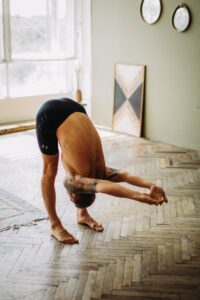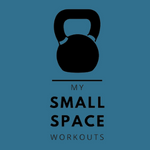I’m going to get straight to the point and let you into the secret: the best home workout routine is the one you stick to!
I know, I know, I’m stating the obvious here, but as I’m going to explain, it’s about time that the simplicity of fitness was brought back into the spotlight, because the fitness media industry is often guilty of over-complicating exercise and obscuring the simple truth that the body will respond to exercise if done consistently over time. The goal of this article, and mysmallspaceworkouts.com is to keep your focus on the important stuff: how to exercise, when to exercise and what results should I be expecting?
Why Workout at Home?
 2020 and the Covid lockdown showed us that we can’t afford to allow our workouts to be confined only to the gym. We should all know how to work out at home in such a way that we always have our fitness routine available to us. The benefits of building a small space workout routine is that you can also take it with you when you’re away from home, either for work or leisure.
2020 and the Covid lockdown showed us that we can’t afford to allow our workouts to be confined only to the gym. We should all know how to work out at home in such a way that we always have our fitness routine available to us. The benefits of building a small space workout routine is that you can also take it with you when you’re away from home, either for work or leisure.
Aside from the recent necessity of being able to workout at home, it’s also just incredibly convenient. Whereas a trip to the gym may take a 3-hour chunk of your day by the time you’ve factored in travel and catching up with your gym buddies after your workout, a seriously effective home workout routine should be taking no more than 55 minutes up – including your post-workout shower!
The startling truth that I discovered during the Covid lockdown was that I got into the best shape of my life, almost by accident! That’s not to say I didn’t make some mistakes – we’ll discuss those in a separate article – but I made rapid improvements to my fitness and body composition during the first 2 months of lockdown and have been able to maintain this level of fitness ever since.
How to Build Muscle at Home
As you can read in the About Me page for many years I was an enthusiastic gym member who dreamt of having a hugely muscular physique. I was typical of many young guys in the 90s and for years I followed routines from bodybuilding magazines, most of which would split the body up into its constituent parts, often focusing on two body parts per session for anything up to 21 sets per body part!
This approach did yield results, but it called for grueling workout sessions often exceeding 90 minutes, four or five times per week. As I got older and my responsibilities changed this just wasn’t an appropriate amount of time to spending on looking after my body.
The other, major disadvantage, of following this kind of routine was that cardio work would very often be relegated to an afterthought. In fact, I was so patchy with it, that sometimes weeks would go by without me even looking at the treadmills! I got some big muscles, but I would be out of breath after climbing a few stairs!
That’s not the way to train.
I now follow the principle of full body training for home muscle building. Full body workouts have many advantages for functional strength and general well being over their bodybuilding split-routine counterparts:
- Full body routines tend to be far more time efficient than split routines, usually taking less than 30 minutes to complete.
- Muscles aren’t worked out as intensely and as such, recover quicker from full body workouts. This places less stress on the body overall and reduces the risk of over training.
- Given the lower risk of over training, workouts can be repeated more frequently, meaning that there is more opportunity for hypertrophy (muscle growth).
- The above factors all contribute to achieving a rapid improvement in muscle size and tone.
How to Lose Belly Fat at Home
Try this one weird trick… sorry, I couldn’t resist!
It’s generally accepted that we can’t target fat loss on a specific area, but rather we have to make improvements to our diet and exercise regime and then, over time, see the improvements in our body composition.
For a long time I subscribed to the belief that HIIT (High Intensity Interval Training) was a scientifically proven way to reduce body fat effectively, with many sources talking up the after-burn effect of this kind of workout. The after-burn effect essentially refers to an increase in calories burned for a period of around two hours after the workout has ended.
However, there have been some recent studies in 2016 and 2019 that suggest the benefits of HIIT isn’t as significant as previously believed and that these kinds of workouts are actually less effective than traditional steady cardio (or as they refer to it, ‘moderate-intensity continuous training’). The 2019 study did concede however that compared with MICT, short-term HIIT is more time-efficient in terms of improving cardio-respiratory fitness and psychologically, they are more appealing than a lengthy cardio workout.
My own experience is that HIIT workouts, particularly those using a kettlebell, is that they make me sweat like nothing else! I can’t say with any certainty that all that sweating helps to reduce fat levels, but they certainly contribute to overall fitness and particularly muscular endurance.
For this reason, HIIT workouts have a place in the best home workout routine, but to address that evergreen goal of losing belly fat, we have to get to the heart of the matter!
Home is Where the Heart is
 It is generally advised (see heart.org) that we should get 30 minutes of aerobic exercise 5 days a week for a healthy heart. Aerobic exercise is defined as moderate exercise which elevates our heart rate to between 55 to 80% of the maximum heart rate for our age. Your maximum heart rate can be calculated by deducting your age from 220.
It is generally advised (see heart.org) that we should get 30 minutes of aerobic exercise 5 days a week for a healthy heart. Aerobic exercise is defined as moderate exercise which elevates our heart rate to between 55 to 80% of the maximum heart rate for our age. Your maximum heart rate can be calculated by deducting your age from 220.
With the advent of cheap heart rate monitors, I was able to analyse what my heart was doing during exercise and the results were shocking:
- My heart rate in weightlifting based workouts would be below the target zone.
- My heart rate when running was above the target zone (I live in a very hilly area which makes it difficult to dial down the intensity).
- My heart rate when doing HIIT workouts would spike towards the maximum but would fall out of the zone for most of the duration of the workout.
- Walking was insufficient to raise my heart rate into the target zone unless I walked so fast that I looked and felt uncomfortable!
So for all the exercise I was doing, my poor heart wasn’t getting the exercise it needed. Again, this is an area where I think the fitness media industry lets itself down: there is too much emphasis on going to extremes of exercise and too little written about the importance of looking after that muscle which sends blood to all the others! I suppose articles about doing steady state cardio for 30 minutes aren’t all that interesting compared to reading about training for a crossfit competition or ultramarathon.
But we should be eager to workout in this heart rate zone as research shows that this is the zone most effective for burning fat and can even add years to your life!
So what can we do at home to get our heart rate in the cardio zone for 30 minutes? The answer is simple: snap on that leotard, reach for the sweatband and head on over to YouTube to search out an old-school aerobic workout.
Seriously, I have found a few excellent aerobic workout videos that are fun enough to ensure that the time passes quickly, but active enough to keep my heart rate right where I want it to be, in the middle of the target zone. I can’t overstate the importance of this kind of exercise.
Putting it all Together
We’ve looked at the key elements of the perfect home workout routine. But what would that routine look like in practice and how much time would it take up?
I’ll answer that very question next time.
In the meantime, stay healthy and keep moving!


You a very organized, informative website. It was easy to navigate.
I enjoyed learning about your small space workouts.